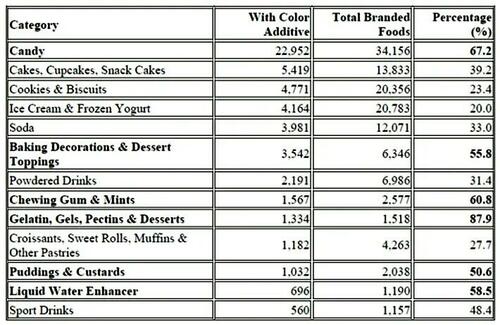How Did Strange Dyes Get In Our Food?
Authored by Jeffrey A. Tucker via The Epoch Times (emphasis ours),
When you buy those beautiful cupcakes and cookies at the grocery store, how much plastic are you eating? This is a burning question these days, as Americans have become newly aware of the real content of mainstream food.
MIT professor Retsef Levi has produced remarkable research detailing the extent of the problem of petroleum food dyes in normal products you eat every day. He did an analysis of 700K products in the USDA Global Branded Food Products Database and found over 85K products with at least one dye and some categories having well over 50 percent of products with at least one dye.
As is well known, these products have been credibility associated with behavioral disorders in the young and carcinogens in adults, which is why most countries in the world do not use them. Many dispute those findings, and arguments run in all directions. But these days, there is great concern about chronic disease in the young and a strong effort to address the issue through every means.
It makes sense that U.S. producers align themselves more with natural rather than synthetic dyes. It’s rather remarkable that the practice has continued as long as it has. Foreign travelers in the United States fear U.S. food in part for this reason. They would rather eat food, not plastic, and worry about what is really in our bright, delicious-looking, packaged foods.
Robert F. Kennedy, Jr. at HHS and Dr. Marty Makary at the FDA have taken aim at six of these dyes (in addition to two already identified under the last administration) and have scheduled them to be phased out as part of the agenda to make America healthy again. In this, they have faced remarkably little pushback. Few are willing to stand up in defense of synthetic dyes in our food and most people have a sense that we would be better off without.
This is why so far, the agreements to get rid of them are voluntary. They rely on cooperative understandings with industry rather than mandates. This seems right to me.
I’m of a libertarian cast of mind and generally feel like people should eat whatever they want. It’s up to the consumer and not government to decide such questions. Producers should use whatever ingredients customers want, and it does seem as if these products on the ban list have more or less been approved by the consumer marketplace.
In principle, I agree with Jeffrey Singer: “The HHS and FDA regulatory monopolies should not infringe on adults’ autonomy to choose less expensive or more visually appealing foods containing these substances, if they wish. Autonomous adults must have the freedom to make their own risk-benefit assessments.”
As usual, however, the situation is more complicated than merely freedom of choice or bans by the government. Vast amounts of the U.S. food industry benefits from subsidies in the form of SNAP benefits and school lunches, among other programs. These provide a high margin of profitability for the producers.
Government is the consumer in this case, and not a very discerning one. Producers manufacture products that sell well for particular industrial purposes. These often require very long shelf lives and the ability to sustain the look and feel of food from having traveled long distances in challenging temperatures.
It makes sense that petroleum and synthetic products make the journey from factory to shelf more easily than natural dyes like fruit juices and spices. The look is entirely different when using real food dyes. I was at a Vietnamese superstore that sells none of the synthetic products because no one would ever buy them. I looked at the colors of the sweets. They are certainly more dull and less optically appealing. On the other hand, they look like food used to look.
I shop often at local markets and trade with local bakeries so I don’t see much of these fake colors in food. Farmers markets don’t use them. On the other hand, these cater to a customer who is health- conscious and pays for the real deal. Most people do not do this.
An investigation into how these synthetic dyes got in our food takes us far back in time to the very first federal food regulation measure of 1906 that centered on regulating the meat-packing industry. The cover story was that it was eliminating unhealthy and dangerous practices. In reality, and as unpacked by many historians, the dominant lobbyists in the text and implementation of the controls were the major industrial firms.
This is how “poke and sniff” became the dominant way meat was inspected in this country. It was the opposite of safe and ended up spreading disease. But it also resulted in much higher costs for the industry that only the biggest players could bear. The practical effect was to drive out small meat packing companies and bolster a growing cartel in the industry. The 1906 act was not really about stopping bad practices, it was about entrenching large businesses as the controlling force of industrial planning.
This was only the beginning of what ended up being a century-long consolidation of the food industry. It firmed up at the New Deal, which implemented a central plan for agriculture complete with production limits, mandates, subsidies, and controls. Price controls in World War II strengthened it further. The mad dash toward gigantic food-production subsidies in the early 1970s consolidated the industry ever more.
Independent farmers were the ones who suffered.
What was being created here was not a “free market” but a food cartel that discriminated hard against small farms and local food and in favor of centralized and industrial methods of production. Ask any local farmer or rancher about the struggles they face. The regulatory barriers are huge and the mandates all-consuming. They cannot simply raise food and sell it. They face a barrage of investigations and regulatory hoops.
A free market is exactly what they want. But it doesn’t exist. They will tell you that the big producers in the market have all the advantages over them wheres they would be fine a genuinely competitive market.
Food production and distribution in the United States is famously consolidated. What seems like infinite choice at the supermarket is really an illusion. Depending on the product, the dominant producers are usually one of the big four: PepsiCo, Tyson, Nestlé, and Kraft. The smaller producers are in the mix but face intractable barriers.
The problem with corporate consolidation is that it creates uniform industrial practices designed less for the consumer and more for the well-being of the company and its systems. These dyes have been fine for that purpose, and perpetuated themselves without an adequate system of feedback from the market they serve.
This is a reason not to blame the free market for unhealthy food. We don’t have a free market. We have a corporatist system in which the biggest players rely on close cooperation with the FDA and other regulatory agencies to protect and consolidate their market share. They get away with practices that otherwise would be punished in a real market with consumer-based accountability.
There is an additional problem with the existence of the FDA itself. Most Americans believe that because of its presence, anything for sale at the store has necessarily been certified as safe and fine to eat. If something says it is healthy, it surely is.
In a genuine market economy without such an overlay of constant assurance from government, we might develop more of a habit of questioning the claims of producers or seeking out better sources of information. There would surely be private and accurate sources to which we could appeal.
In electronics, for example, Underwriters Laboratory has long certified the safety of products. It is not a government institution and gets no support from government so far as I can tell. It makes money entirely from fees from producers who pay to have their products certified as safe. If the company fails in its duties, it would face a huge blowback. The system works.
The FDA, on the other hand, has long presided over a system largely captured by industrial lobbyists, shared patent revenue, revolving doors of regulators from and to industry, and conflicts of interest that are rampant throughout the whole process of food and drug approvals.
The system is deeply compromised to the point that it blesses certain practices in production and distribution that could never survive a legitimate market test. They dominate precisely because market forces are not allowed to operate to enable a correction.
For this reason, and despite my preference for freedom in all matters, I’m not unhappy about the pushes against synthetic food dyes that are now being enacted. Arguably, this should just be the beginning, a course correction. The agencies have served to ratify and protect practices that otherwise would not have survived in a genuine marketplace.
Freedom of choice is essential but so is informed choice and a truly competitive marketplace.
Views expressed in this article are opinions of the author and do not necessarily reflect the views of The Epoch Times or ZeroHedge.
Tyler Durden Thu, 05/01/2025 – 05:00
Source: https://freedombunker.com/2025/05/01/how-did-strange-dyes-get-in-our-food/
Anyone can join.
Anyone can contribute.
Anyone can become informed about their world.
"United We Stand" Click Here To Create Your Personal Citizen Journalist Account Today, Be Sure To Invite Your Friends.
Before It’s News® is a community of individuals who report on what’s going on around them, from all around the world. Anyone can join. Anyone can contribute. Anyone can become informed about their world. "United We Stand" Click Here To Create Your Personal Citizen Journalist Account Today, Be Sure To Invite Your Friends.
LION'S MANE PRODUCT
Try Our Lion’s Mane WHOLE MIND Nootropic Blend 60 Capsules
Mushrooms are having a moment. One fabulous fungus in particular, lion’s mane, may help improve memory, depression and anxiety symptoms. They are also an excellent source of nutrients that show promise as a therapy for dementia, and other neurodegenerative diseases. If you’re living with anxiety or depression, you may be curious about all the therapy options out there — including the natural ones.Our Lion’s Mane WHOLE MIND Nootropic Blend has been formulated to utilize the potency of Lion’s mane but also include the benefits of four other Highly Beneficial Mushrooms. Synergistically, they work together to Build your health through improving cognitive function and immunity regardless of your age. Our Nootropic not only improves your Cognitive Function and Activates your Immune System, but it benefits growth of Essential Gut Flora, further enhancing your Vitality.
Our Formula includes: Lion’s Mane Mushrooms which Increase Brain Power through nerve growth, lessen anxiety, reduce depression, and improve concentration. Its an excellent adaptogen, promotes sleep and improves immunity. Shiitake Mushrooms which Fight cancer cells and infectious disease, boost the immune system, promotes brain function, and serves as a source of B vitamins. Maitake Mushrooms which regulate blood sugar levels of diabetics, reduce hypertension and boosts the immune system. Reishi Mushrooms which Fight inflammation, liver disease, fatigue, tumor growth and cancer. They Improve skin disorders and soothes digestive problems, stomach ulcers and leaky gut syndrome. Chaga Mushrooms which have anti-aging effects, boost immune function, improve stamina and athletic performance, even act as a natural aphrodisiac, fighting diabetes and improving liver function. Try Our Lion’s Mane WHOLE MIND Nootropic Blend 60 Capsules Today. Be 100% Satisfied or Receive a Full Money Back Guarantee. Order Yours Today by Following This Link.









